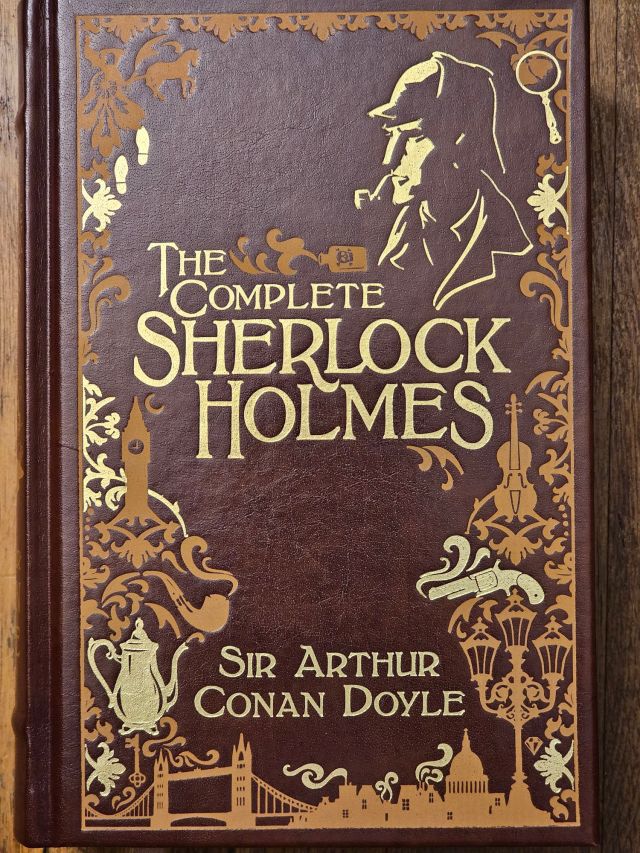The cover art for mystery novels is interesting. Unlike many other popular genres, whose covers feature images depicting the characters in the book doing something which might possibly happen in the book (that part is, admittedly, less common), the covers of mystery novels are frequently iconography. Consider the cover to this Barnes & Noble complete Sherlock Holmes (bought twenty some-odd years ago):

The most prominent is Holmes himself, of course, in his iconic deerstalker cap, inverness coat, and with the curved pipe made iconic for him by William Gillette.
There is also London Bridge, which so far as I know never featured in a Holmes story. Well, not the London Bridge, but a London bridge. That’s actually Tower Bridge. It’s a newer bridge, downstream of London Bridge. It still never featured in a Holmes story, so far as I know, but it is very iconic of London.
There are the buildings of late Victorian London with the smoke coming out of their chimneys and also a street lamp. Also the great Clock Tower (renamed in 2012 to Elizabeth Tower), with the clock popularly known as Big Ben. I don’t believe that it ever featured in a Sherlock Holmes story, either. Like Tower Bridge, though, it is symbolic of London, and Holmes is inextricably bound up with London.
There are also a few symbols of Holmes himself—the curved pipe above the tea pot and the violin. These are quite straight forward.
Then there are symbols of some of the mysteries, or at least of mysteries in general. Starting in the lower left we have an old fashioned key. Certainly keys have fit into Sherlock Holmes stories, though they also work as symbols of detective fiction in general—the detective is always seeking the clue which is the key to the mystery. On the lower right we have a diamond, presumably the blue carbuncle, though it might be a more generic diamond symbolizing the wealth for which people commit crimes.
A little higher we have a silver tea pot—certainly the British in Sherlock Holmes’ time drank a lot of tea. I don’t recall a tea pot being crucial in a Holmes story, though I feel like I might just be forgetful, here. They can easily fit into issues of poisoning, though.
Then we have a smoking gun. What could be more iconic of a murder mystery than a smoking gun? Well, a knife dripping blood, perhaps, but it’s close. There were many Holmes stories featuring guns, though of course the Problem of Thor Bridge comes to mind.
In the top left we have footprints—oh, what can be more iconic of a golden age mystery than footprints? Holmes certainly identified more than his fair share of footprints in the stories.
And then, in the top right, we have Holmes’ powerful magnifying lens. Or, more colloquially, his magnifying glass. What an icon of Sherlock Holmes!
He used a powerful magnifying lens a few times in the stories, of course. Even if he didn’t, it would be such a great symbol, though. A magnifying glass represents sight, as well as focus. One of the great themes of Holmes instructing Watson in his methods is, “you saw, but you did not observe.” There was something similar in a Poirot story, though I can’t find it at the moment. Poirot was remarking that it is not enough to see the facts, you must understand them, or else the pigeons would be the greatest detectives since they see everything that goes on.
The magnifying glass does also symbolize powerful vision, since it makes details greater, but I think that the focus is of greater symbolic importance since the intrinsic tradeoff of the magnifying glass is that you see some things more clearly at the expense of seeing other things not at all. When you look through a magnifying glass, you have a very narrow field of view. It is thus imperative that you look at the right things. And it is that quality of judgement which is really the epitome of the detective, or at least of the most interesting kind of detective. There are the Dr. Thorndykes of the world who do their chemical analyses and present the findings, or even the Encyclopedia Browns of the world who just know an enormous number of facts which occasionally come in handy. But the greatest detectives are those who can see what other men see and understand it where they don’t. And few things represent that as well as does a magnifying glass, since any man can use it, but few know where to look with it.

The fun thing is that the pipe comes from William Gillette, and is because it’s easier to say lines with it than a straight pipe. (Easily the most influential actor in the role of Sherlock Holmes, since he influenced Doyle.)
LikeLiked by 1 person